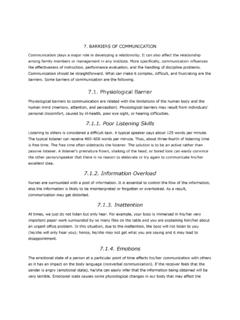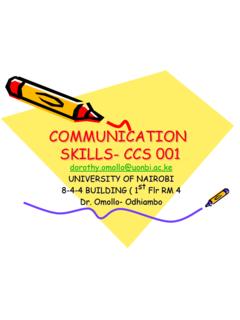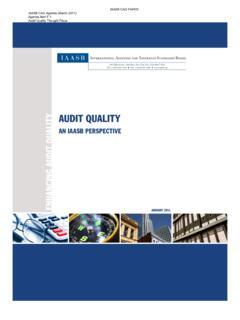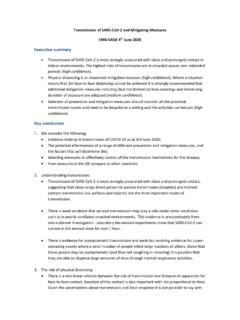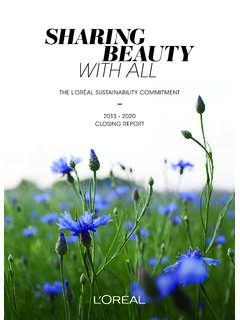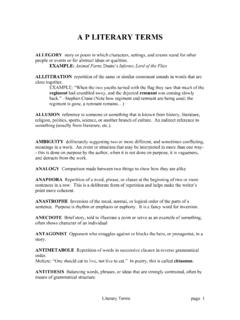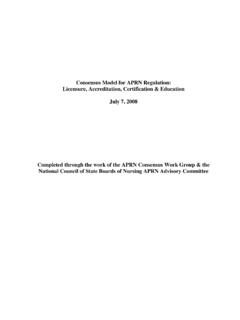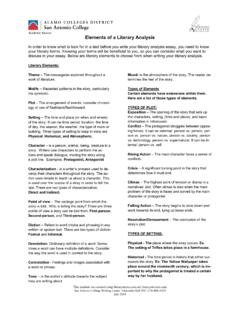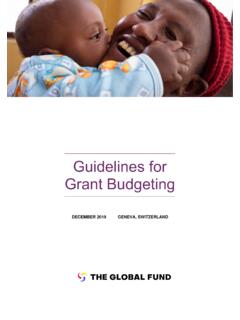Transcription of Introduction to Communication Skills
1 Communication Communication Communication Skills - CCS 001 Skills - CCS 001 Skills - CCS OF NAIROBIUNIVERSITY OF NAIROBI8-4-4 BUILDING ( 18-4-4 BUILDING ( 1stst Flr RM 4 Flr RM 4Dr. Omollo- OdhiamboDr. Omollo- OdhiamboTHIS LECTURE IS ABOUT TO YOU ARE IN POSSESSION OF A CELL PHONE, KINDLY TURN IT OFF NOW!Who am D. Omollo- Odhiambo ( BED, M ED, Phd Health Communication - School of Journalism and Mass Commmunication Lecturer, UON Dept of Communication Skills and of COMM. Skills Unit Aim is to equip students with Communication Skills suitable for academic and career purposes: impart knowledge, attitudes and Skills for University academic By the end of the course, students should be able to: - Communicate effectively for academic purposes. - Apply requisite comm- Skills . -Demonstrate understanding of generic fundamentals of schedule CCS-001- 4 SKILL AREAS Begins with Introduction to Academic Communication Skills Academic Writing Skills , Academic Reading Skills , Public speaking and oral presentation Skills , Functional writing Skills ,Course Evaluation CATS in each given skill area Final summative examination for two hours in all Skills taught Class participation and expectation that each student will have to exhibit mastery and knowledge of each Communication skill area.)))
2 Contact hours is 45 hrs including two hrs exam COURSE will be taught through Lectures, Group discussions and individual student presentationsRecommended Readings/Books Afoloyan, A & Newsum, ( I986)The Use of English Commmunication Skills for University Students. London: LongmanComprehensive reading list in the Course outlineImportance of Communication Comm- Skills not just handy; they are critical tools for success Important for survival in real world environment, Critical for propagation of kldge and development; Managing change/ conflicts effectively, Comm- Skills are the building blocks of academic life and career, Comm- Skills occupies central position in a students life and that of practicing professional; Basic Skills for survival at university, higher of Communication Useful in training of professionals and acquisition of: -Cognitive Skills - Psychomotor-(Technical) Skills -Social ( Comm.)
3 Skills )All professionals need more than specialized kldgeImportance of CommunicationIntroduction What is Communication ?In simple words we can say that just to convey the message If we go in more detail we can say that Communication is the process of transmitting (A B) & Receiving (B A) Defined Theodorson ( 1969): Defines comm. as the transmission of information , ideas, attitudes, or emotions from one person or group to another or others primarily through symbols Osgood et al. (1957) There is Communication wherever one system or source influences another, by manipulation of alternative symbols transmitted over the channel Communication Defined Gerber ( 1957) defines Communication as social interaction through messages. Comprehensive: Communication is the process of transmitting information and messages from one point to another for the purpose of eliciting action actions that will accomplish a specific goal.
4 Communication is done with the intention of influencing an audience As a process, Communication is not discrete, static or solitary. It exists in time and changes constantlyOrganizational Comm. Process by which info is passed between individuals, groups or depts and externally to customers, clients, suppliers, and other stakeholders by means of previously agreed symbols for purposes of eliciting appropriate action to enhance orgs image, efficiency and Communication :- If some one achieve the desired level of objective through Communication , we can say that it is effective Communication . If your Communication get the proper response from the receiver it means that you effectively conveyed the creative and Critical ThinkingConsider audience s information needsConsider Audience's Technical BackgroundConsider Audience's Cultural Background and GenderConsider Audience's Knowledge of the SubjectHow to achieve effective CommunicationWhat is effective Communication ?
5 Consider the possibility of Communication FailureExpect audience resistanceRecognize Communication constraintsLegal, social economic, psychological, institutional,cultural etcUsing gender-neutral terms for occupations, positions, roles,Terms that specify a particular gender can unnecessarily effect certain stereotypes when used generically. Avoid This Use Use This Instead businessman businessperson, executive, manager, business owner, chair, chairperson fireman firefighter housewife homemaker layman layperson, no specialist, nonprofessional postman mail or letter carrier policeman police officer or law enforcement officer salesman, saleswoman, salesperson, sales representative, sales associate, salesgirl spokesman spokesperson, workman worker Components of Internal Means External (Encoder) (Decoder) BackContext Context tells us reason for Communication and reasons may : Internal means a company wants to Discuss an idea/Issue to its employees the message should be either in writing or verbalExternal.
6 In eternal context some query from stakeholders or from outside the organization- You may response to query Email Fax Telephone Letter Verbal (Encoder) When you sending the message, you are the Encoder . Here the word you mean writer/Speaker decides whether the message should be in written or oral. He/She may choose Words, Symbols, Pictures or Graphics that express the objective in the real sense. Encoding can be conscious or unconscious ( Unconscious way of denoting means) yawning could denote hunger, fatigue Conscious: Waving could denote friendliness. Message Message is basically the basic idea that you want to communicate. The message may be Verbal, means (Written or Spoken) Non-Verbal, means( Symbols, Pictures or unspoken). This is very much important component of Communication Your message should be or MUST be clear and easy to understand The most important element in message is your receiver.
7 You must be well aware about your receiver. While preparing a message you should keep in mind how your receiver will interpret the message. Message (Cont.) You (Sender) should also keep in mind your relationship with the receiver while preparing message. some times wrong message may create a loss to your organization , to yourself. or it can create a bad impression for you/your Medium is basically channel through which your message reaches to receiver & channel vary from situation to situation. Let s say Govt of Pakistan wants to convey its message to Pakistani Nation , now Govt will select the effective medium it may be. Radio Papers Or all of the above keeping in view the Importance of the message. When we talk at Micro /Organizational Level the medium may be writing or non-VerbalReceiver (Decoder) To whom the message is being in case of Govt of Pakistan's Message, Pakistani Nation is receiver (Decoder).
8 In simple words we can say that receiver is your reader (in case of press , letters etc.) or Listener (In case of TV, radio, Speaker Etc.) Receiver is also known as Feedback is basically the response/reaction of Receiver after receiving the message. Sender always need feedback to check weather the message effectively reached or Or in other Sender need feedback to examine the success or failure of the traits of a scientist1) lab coat 2) eyeglasses 3) facial hair 4) large amounts of hair on head 5) symbols of research: scientific equipment, laboratory instruments 6) pens in the pocket 7) male. Any QuestionModels of the Communication Process Shannon s Model: Beginning of Communication field, Reduces Communication to a set of 8 basic components: source, the message. Transmitter, the signal, channel, Noise/ barriers, receiver, destination. Kottler s Model Most direct and straight foreward model, All elements can be classified into three groups: Parties: sender, receiver, writer, speaker Tools: message and medium Functions: encoding, Decoding, Response, FeedbackOther Models Interactive Model Ecological model Transactional Model4 Levels of Communication INTRAPERSONAL: Lang.
9 Use or thought internal to communicator Internal involvement of an individual in symbolic processing of messages Individual becomes sender and Receiver, provides feedback to self in ongoing internal Intrapersonal is an aspect of interpersonal. dialogue is the foundation of all discourse Intrapersonal comm. can encompass: -Day Dreaming, Talking to oneself, within socially acceptable situationsWriting ones thoughts & observations etc Interpersonal comm. dialogue / sharing comm between 2-3 or more pple who are interdependent on one another, have shared history Channels could be direct or indirect direct channels are obvious , can be recognized by receiver, verbal and non verbal channels. indirect : those are recognized subconsciously by receiver, no direct control of Comm. Encompasses: Speech Communication , Non verbal, unconscious comm, Turn-taking, managing the flow of info, back and forth, Usage: Parenting, Intimate rels.
10 Management, selling, counseling, Coaching, mentoring Components Channels: means/ mode of transmission Participants: Communicators- sender and Receiver, Context: Refers to interrelated conditions of comm. includes, physical environment, people, etcGROUP TEAM Comm. that occurs in groups of between 3-12 individuals. Small group Communication takes place in contexts that mixes interpersonal comm & social clusteringPUBLIC Communication Large groups, could be whole nation or crowd. ITS at the heart of the economy, politics, and society, Advocates use it to promote a social course, business use it burnish their image; It is a field built on ideas and images, persuasion and informationPublic Communication Requires strategy and tactics No policy or product can succeed without smart messages targeted to the right audience in a creative and innovative of Comm.
